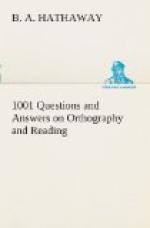240. How may low tones be acquired?
By continued practice in a lower key than
the natural.
241. How may a high key be acquired?
In the same manner as a low key; by pitching
the voice first
a
little higher than the natural, and mastering that
thoroughly,
then still higher and higher.
242. What is meant by Rotundity of
the voice?
That peculiar form of tone which the Romans
called “Ore rotundo,”
which
signifies “Round mouth.”
243. In what kind of sentences is the
Rotundity of the voice
exemplified?
In the hailing of vessels, and is used
especially by sailors and
officers.
244. Which is the most difficult:
to raise the voice to a higher
pitch,
or to bring it to a lower?
The lowering of the voice is more difficult,
and requires great
care
and practice.
245. What is a common fault with most
public speakers?
To run the voice into too high a key,
and thus weary the hearers.
246. What is a good rule by which to
govern the voice?
To start on a key lower than the natural,
and thus avoid running
too
high.
247. What are the principal styles
of different reading
selections?
Descriptive, Narrative, Senatorial, Moral,
Didactic, Dramatic, and
Amusing.
248. What tone of voice should be used
in reading a Descriptive
selection?
The ordinary, natural tone, with a careful
use of emphasis.
249. What tone of voice is best adapted
to the reading of a
Narration?
The conversational tone, with as little
reference to the printed
page
as possible.
250. What style is the best adapted
to Senatorial reading?
An imitative style and tone, being careful
in the use of the
emphatic
pause.
251. What tone is best adapted to the
reading of Moral and
Religious
selections?
Low and moderate tone, expressing feeling
and sentiment, being
careful
not to read too fast.
252. What style is best adapted to
Didactic reading?
That peculiar style which is best adapted
to impart instruction,
laying
special stress on the important idea.
253. What style and tone are best adapted
to the reading of
Dramatic
selections?
A style and tone which are entirely imitative
in character.
254. What tone or character of voice
is best suited to the
rendering
of Amusing selections?
That which will bring out the mirthful
sentiment, to the exclusion
of
all rules for accent, emphasis, etc.
255. Should all persons use the same
tones of voice and style in
reading
selections?
They should not; as individuals are differently
constituted,
so
they have different ways of expressing their ideas
and
sentiments.




